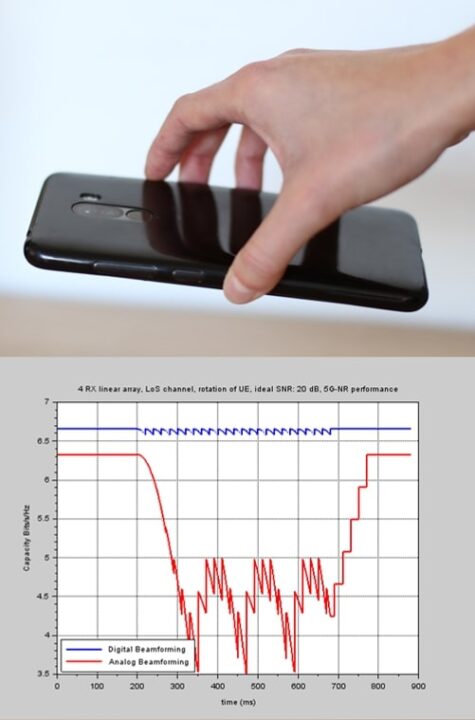Did you know that a person picks up the smartphone 250 times a day?
The smartphone is in your pocket or on the table. Suddenly you hear a buzzing sound, you pick up the phone and check the chat message you received on your device. On average, a person does this procedure 250 times a day according to a recent study!
This pick up the phone scenario is one of the trickiest situations to handle when using mmWave radio frequencies ; the communication between the mobile device and the base station is done using antenna arrays and beams. During the time you pick up the phone from the table (it takes roughly 0.5 seconds) the communication direction between the antennae in the smartphone and the base station changes a lot, thus in order to maintain the communication with the base station the processor in the device needs to perform beam-tracking.
In traditional mmWave radio system solutions using analog techniques, the beamforming (signal combining) is made in the analog domain close to the antennae, using phase shifters, and a combined signal is fed to the digital processor performing the beam-tracking. Since the processor only sees the combined signal, it needs to guess how to change the signal combining once it recognizes that the received signal strength has started to deteriorate. If the direction towards the base station changes very quickly, the beam tracking will always be lagging, with the result being that the device will not be able to receive the signal from the base station and hence not be able to transmit the signal in the right direction to the base station. Very low data rates (causing lagging), or even a dropped connection, is the result you will see on your smartphone.
Using a mmWave digital beamforming solution, the beamforming (signal combining) is performed in the digital processor after the digital processor has estimated the direction of the incoming signals. Using optimized beam-tracking algorithms, implemented in the processor, the signal can still be tracked even in this challenging scenario, and the performance will therefore not deteriorate as in the case using analog beamforming.
BeammWave has developed smart algorithms, optimised for a sustainable and scalable digital beamforming solution, thereby handling all kinds of challenging scenarios and minimizing the risk of lagging and performance degradation when the device operates using mmWave communication.
